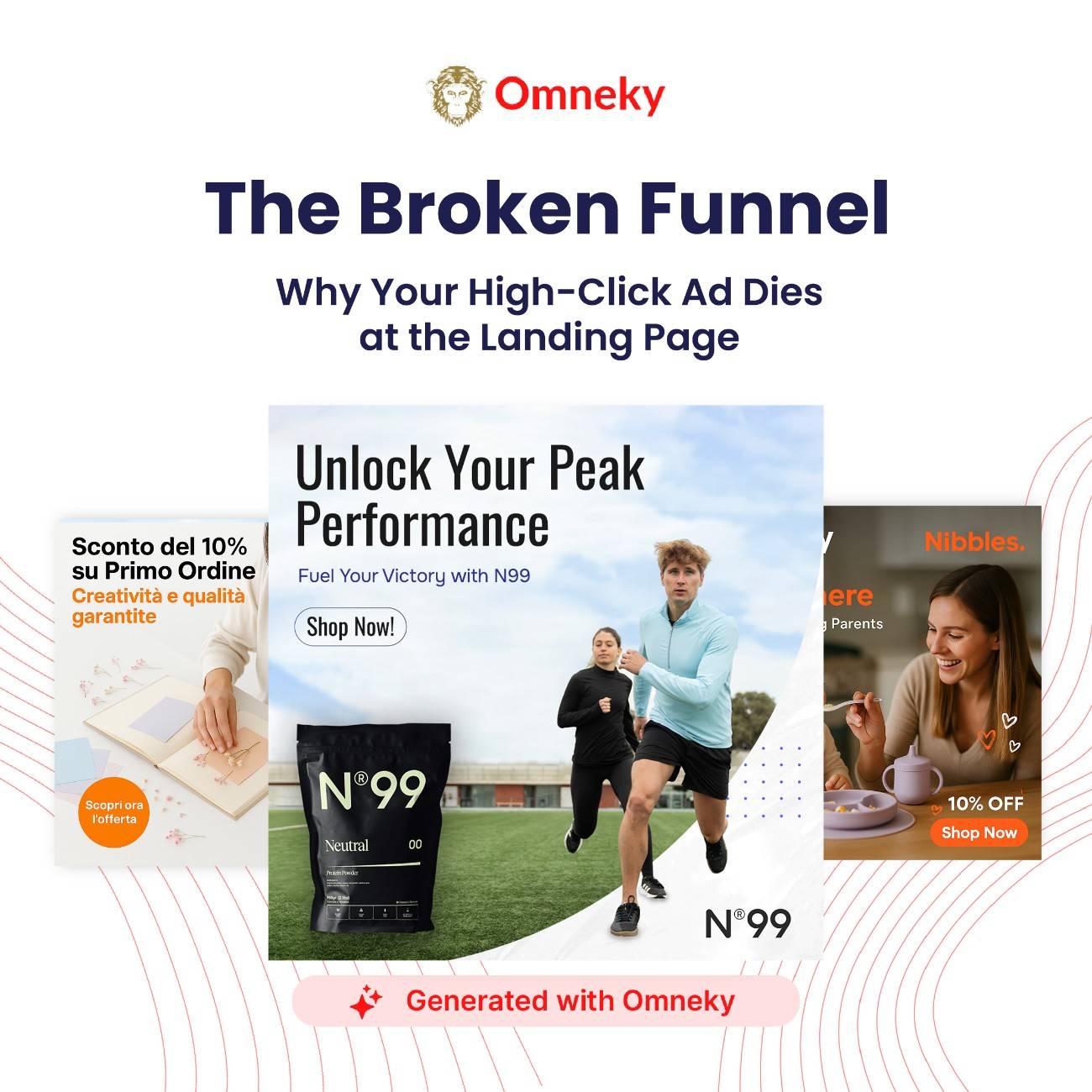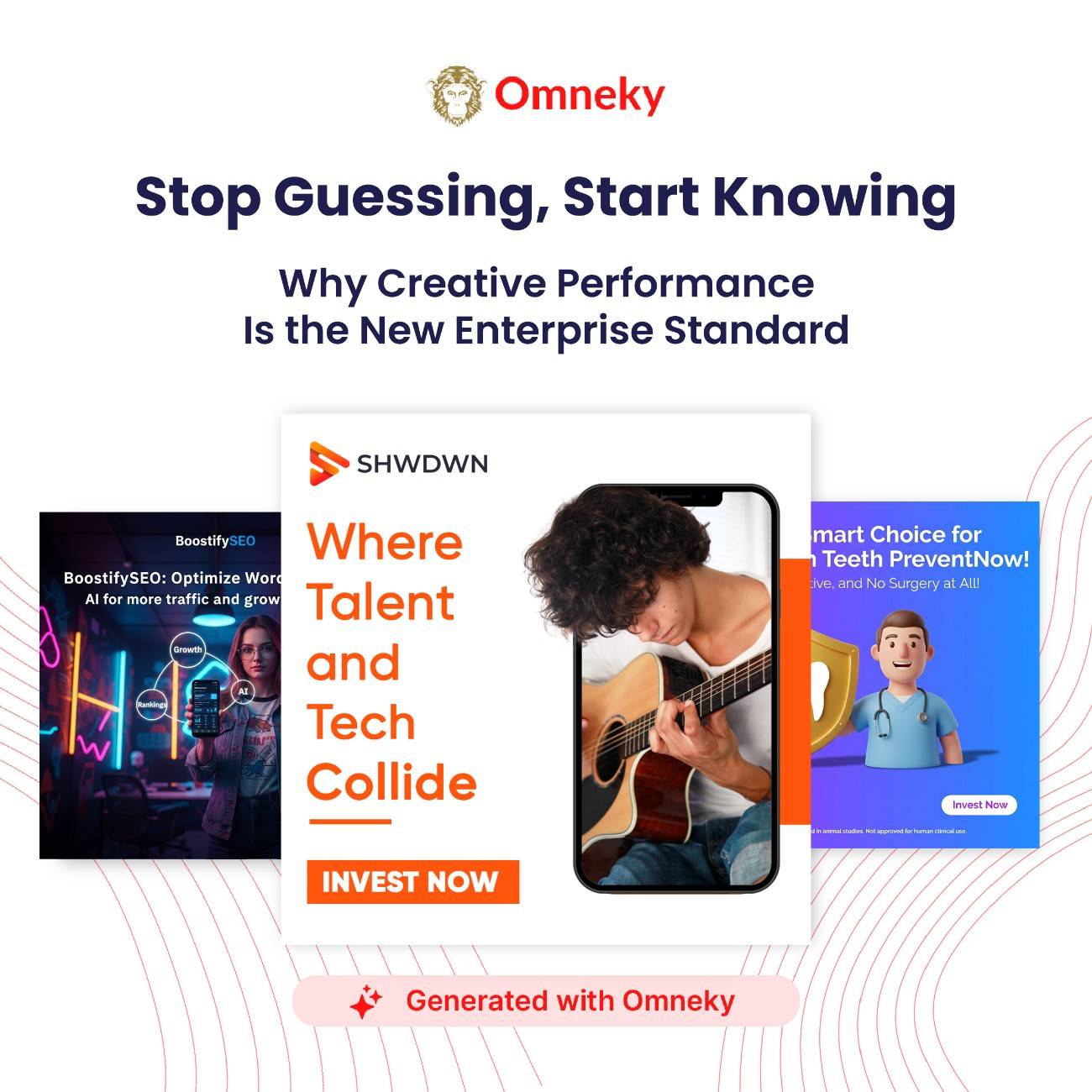パフォーマンス・クリエイティブ・プレイブック:ループを閉じるための企業向けガイド
何年もの間、クリエイティブ部門はブラックボックスでした。マーケティングチームはキャンペーンの説明を受け、クリエイティブチームは美しいアセットを配信し、メディアチームは最高のものを期待してそれらをライブ配信しました。「何がうまくいったか」は推測であり、「なぜうまくいったのか」は謎でした。

パフォーマンス・クリエイティブ・プレイブック:ループを閉じるための企業向けガイド
イントロダクション:「グッド・イナフ」クリエイティブの終焉
何年もの間、クリエイティブ部門はブラックボックスでした。マーケティングチームはキャンペーンの説明を受け、クリエイティブチームは美しいアセットを配信し、メディアチームは最高のものを期待してそれらをライブ配信しました。「何がうまくいったか」は推測であり、「なぜうまくいったのか」は謎でした。
その時代は終わりました。
今日の企業リーダーが求めているのは、ただ求めることだけではありません。 よりクリエイティブに、より速く。彼らは要求が厳しい よりスマートなクリエイティブ、測定可能な結果。クリエイティブジェネレーションをROASに直接つなぎ、ブランドと法令の遵守を 100% 保証し、パーソナライゼーションをあらゆるグローバル市場に拡大するクローズドループシステムが必要です。
これが新しい標準です パフォーマンスクリエイティブ。
このプレイブックは、サイロ化された主観的なクリエイティブプロセスから、クリエイティブを最も予測可能な成長の原動力に変える単一のインテリジェントなシステムに移行する方法について、エンタープライズリーダー向けのガイドです。
パート1:コアファンデーション(新しい「マストアイテム」)
第1章:ボトルネックからブレークスルーへ:プラットフォーム固有のクリエイティブオーケストレーションが譲れない理由
「フリーサイズ」のクリエイティブの時代は終わりました。
何年もの間、マーケティングチームは壊れたモデルで運営してきました。つまり、1 つのヒーロークリエイティブをデザインし、それを手作業で(そして痛々しいほど)切り刻み、サイズ変更して、他のすべてのチャネルに合わせて調整するというものです。その再利用されたYouTube広告は、インスタグラムのストーリーに詰め込まれました。その静止バナーはしぶしぶLinkedInに投稿されました。プラットフォーム固有のコンテンツに対するこの「あれば良い」アプローチは十分だと考えられました。
今日、「十分」は失敗の秘訣です。
オーディエンスは1つのプラットフォームだけでなく、メタ、TikTok、LinkedIn、YouTube、その他無数のプラットフォームに分散しています。そして、彼らはただそうしているだけではありません。 好む ネイティブコンテンツ—彼ら 期待 それ。ユーザーがTikTokをスクロールすると、目的を変えた耳障りな広告がすぐにスキップされますが、次のような動画には反応します。 感じる TikTokみたいな
この変化により、ワークフローの不便さが重大なビジネスボトルネックになっています。プラットフォームに特化した迅速なクリエイティブオーケストレーションへの需要は、もはや「あればいいもの」ではなくなっています。 生存と成長に欠かせないものです。
マニュアル・タックス:レンダリングとサイズ変更に溺れる
現代のマーケティングチームは、手作業に追われているため、解決策を求めています。彼らのクリエイティブチームはボトルネックになっており、パフォーマンスも低下しています。
ブランドマネージャーやパフォーマンスマーケターからの需要リストは明確かつ緊急です。
- プラットフォームに合わせたフォーマット: 彼らはやめる必要がある サイズ変更 そして開始 再構成。9:16 の TikTok、1:1 のメタカルーセル、4:5 のフィード投稿、16:9 のYouTube広告は、根本的に異なるキャンバスです。
- 絶え間ない自動更新: そして、疲労はパフォーマンスの敵です。チームは、クリエイティブコンセプトを毎日ではなくても毎週更新する必要がありますが、これを手動で大規模に行うことは不可能です。
- フィード主導型クリエイティブ: Eコマースや小売ブランドには、自社の商品カタログ (Shopifyなど) に直接リンクし、最新の商品、価格、プロモーションを自動的に取り込む広告が必要です。
- ダイナミックエレメント: 関連性を高めるには、アダプティブ動画、ダイナミックオーバーレイ(「送料無料」や「24時間セール」など)、ローカライズされたコンテンツを追加できることが不可欠です。
- 一元化されたワークフロー: チームは、スプレッドシート、メールチェーン、ばらばらになったアセットフォルダを操作することにうんざりしています。彼らは信頼できる唯一の情報源を求めています。
- シームレスな統合: クリエイティブなプロセスでは、DAM(デジタルアセット管理)から広告マネージャー自身に至るまで、スタックの他のメンバーと連携して、わかりやすいトラッキングを実現するための完璧な命名規則を身に付ける必要があります。
これを手動で行うと、時間、費用、およびパフォーマンスに「手動税」がかかります。AI とオーケストレーションを使用すれば、競争上の優位性が生まれます。
解決策:「ワンブリーフから多プレースメント」への革命
この要求を満たす唯一の方法は、手動による適応からインテリジェントなオーケストレーションに移行することです。これが新しい標準です。
想像してみてください 「1つのブリーフから複数のプレースメントへ」ワークフロー。マーケティング担当者は、1 つのブリーフ、コアメッセージ、および一連のアセットを提供します。そこから、オーケストレーションエンジン (Omneky など) はサイズを変更するだけでなく、インテリジェントに生成します。 数百 プラットフォームネイティブバリアントの
これがその仕組みです:
- インテリジェントレイアウト: システムは、各プラットフォームのコンテキストを理解します。アスペクト比とレイアウトは自動的に行われます。 推奨事項、すべての画面に最大のインパクトを与えるように要素を再構成します。
- フィード・トゥ・クリエイティブ・パイプライン: Shopifyストア、商品フィード、またはデータソースに直接接続します。デザインファイルに人が触れることなく、新商品、値下げ、ベストセラーが新しいクリエイティブバリエーションに自動的に反映されます。
- 迅速な反復: これが真の疲労との戦い方です。10 種類のバリュープロポジション、5 種類のCTA、3 種類の商品イメージをテストして、150 種類のユニーク広告を数週間ではなく数分で生成できます。
スピード勝利:ピークシーズンに向けたコネクテッドパイプライン
これはただクリエイティブにすることだけではありません。についてです 打ち上げ それ。
島にある創造的な道具は役に立たない。オーケストレーションの真の力は、 完全に接続されたエコシステム。つまり、クリエイティブエンジンを広告マネージャー、DAM、電子商取引プラットフォームに直接接続するネイティブコネクタです。
ここでスピードが武器になります。Omneky では、創造の速度を高めるために SLA (サービスレベル契約) を発行することが大切だと考えています。ブランドは、コンセプトからライブキャンペーンまで進めることができるはずです。 24~72時間で数百種類のバリエーション
これが「ピークシーズンのプレイブック」です。ブラックフライデーのような期間には、クリエイティブの刷新を2週間待つわけにはいきません。パフォーマンスデータに対応する必要があります。 今。オーケストレーションされたパイプラインがあれば、午前10時に好調なトレンドを見極め、午後1時までに50種類の新しい広告バリエーションを立ち上げ、競合他社がまだ最初のサイズ変更を待っている間に市場を獲得できます。
第 2 部:企業における必須事項 (制御によるスケーリング)
第2章:ベロシティトラップ:ガバナンスなしでクリエイティブを拡大することが企業レベルのリスクとなる理由
クリエイティブの拡大競争において、ほとんどの AI プラットフォームが重視するのは 1 つのこと、つまり速度です。動画は何本作成できますか?1 時間以内に作成できる広告バリエーションはいくつですか?
しかし、企業にとって、制御できない速度は、危機を発生させるより迅速な方法に過ぎません。
金融、製薬、保険、その他の規制対象業界のブランド、または苦労して定評のあるグローバル企業にとって、ブランドから外れた広告、コンプライアンス違反の広告、または法的に公開された広告が 1 つあれば、何か月にもわたる作業が無駄になってしまいます。ある不正なクリエイティブがもたらす法的・財務的な影響は、壊滅的なものになりかねません。
これがベロシティトラップです。だからこそ、企業にとって、 ブランドガバナンスとコンプライアンスはオプション機能ではありません。これらはすべて基盤です。
マニュアル「ノーの部」が壊れている
今日、企業のマーケティングチームや法務チームからの「質問」は明確で緊急であり、摩擦に満ちています。
- 「100 ページにも及ぶブランドガイドライン PDF を取り込んで作成する方法 強制力のある?」
- 「ロゴ、色、レイアウトのルールが適用されることをどのように保証できますか? 1,000 件すべて 広告バリエーション?」
- 「製薬業界の複雑な免責事項を自動的に追加して、「公正なバランス」を確保するにはどうすればよいでしょうか?」
- 「すべてのクリエイティブがADAアクセシビリティに対応していることを検証するにはどうすればよいか?」
- 「偏った画像やインクルーシブでない画像を止めるにはどうすればいいですか? 前 フラグが立てられますか?」
- 「法務部門から求められた場合に、自動コンプライアンスログを提供するにはどうすればよいでしょうか?」
これまで、その答えは手作業によるレビュープロセスでした。これは、法務チームとブランドチームがボトルネックとなり、すべてのアセットをチェックするためにすべてを遅らせる「ノー部門」です。
このモデルは壊れています。スケーリングしない。週末のフラッシュセール用に作成された 500 種類の新しい広告バリエーションを手動で確認することはできません。次の項目を選択する必要があります。 スピードか安全か?
解決策:AI クリエイティブへのガバナンスファーストのアプローチ
あなたはその選択をする必要はないはずです。スピードと安全性の両方を実現する唯一の方法は、クリエイティブ生成エンジンの中核にガバナンスを組み込むことです。
Omnekyでは、ガバナンスを後から考えたものから、プラットフォームの中核となる柱に引き上げました。私たちが構築したのは オムネキーガバナンススイート ブランドチームと法務チームを移転するには リアクティブゲートキーパー に プロアクティブアーキテクト。
仕組みは次のとおりです。
- ブランドルール自動取り込み: 私たちのプラットフォームは、LLMとコンピュータービジョンを使用して 既存のブランドガイドラインを読んで取り入れましょう—PDF、ウェブサイト、Figma ファイルのいずれであっても。ロゴの配置、カラーパレット、フォントの使い方、空きスペースに関するルールを即座に理解し、静的なガイドラインを有効かつ強制力のあるルールセットに変えます。
- 業界固有のコンプライアンス・プリセット: ガバナンスは万能ではありません。製薬広告には銀行広告とは異なるルールがあります。スイートには以下が含まれます。 業界別のコンプライアンスプリセットすべてのクリエイティブが、それぞれの業種に特化したポリシーセーフな基盤から始まるようにしています。
- トータルコンプライアンスのためのリアルタイム検証ツール: 当社のシステムはクリエイティブをチェックします 生成中後じゃなくてこれには、ブランド検証ツール、アクセシビリティ (ADA) 検証ツール、および包括性とバイアス検出が含まれます。
- アイアンクラッド・オーディット・トレイル: オムネキーが提供するのは 自動化されたコンプライアンスログと監査証跡 あらゆるクリエイティブアセットに。どのルールが適用され、どのチェックに合格し、誰が最終アセットを承認したかを即座に確認できます。これは、説明責任を果たし、安心できる証拠となる記録です。
信頼は譲れません。必要なのは AI クリエイティブツールだけではありません。AI クリエイティブが必要です。 パートナー お客様の管理、安全、コンプライアンスに対する譲ることのできないニーズを理解しているのです。
第3章:「隠れた」堀:政府機関や規制対象ブランドがワークフローにOmnekyを選ぶ理由
ジェネレーティブAIについて誰にでも尋ねれば、スピードについて話すでしょう。銀行のゼネラルカウンセル、製薬企業の規制担当マネージャー、またはグローバル機関のアカウントディレクターに尋ねると、「リスク」、「コントロール」、「カオス」などの言葉が聞こえます。
このようなハイステークスの環境では、クリエイティブなアウトプットの良し悪しは、 制御システム それが支配するんだこれが、政府機関や規制対象企業にとって、AIプラットフォームの最も重要な機能は生成エンジンではない理由です。
それがワークフローです。
このコンプライアンスグレードのワークフローは、Omnekyの隠れたモットです。これが、信頼度の高い組織がクリエイティブ業務の推進に当社を選ぶ理由です。
神話:スピードと安全のどちらかを選ばなければならない
何十年もの間、規制対象業界の運用モデルは単純でした。 コンプライアンスは摩擦に等しい。 リスクを軽減するための必須のボトルネックは、法務、規制、ブランドという「ノーノー部門」でした。
規模を拡大する唯一の方法は、コンプライアンスを構築することです に 最初の一歩からのワークフロー
「コンプライアンスグレードのワークフロー」とは?
これは、次の 3 つの信頼の柱に基づいて構築されたエンドツーエンドのシステムです。
- 最初のガードレールとしてのブランドLLM: あの 知的な ワークフローはエラーの発生を防ぎます。私たちの ブランド合同会社 交渉の余地のないルール(法的免責事項、「フェアバランス」テキスト、ロゴルール)を把握し、防御の最前線として機能します 前 1 つのクリエイティブが生成されます。
- 自動多段階承認: レビューチェーンは複雑です。私たちのワークフローはそれを自動化します。アセットは適切な人に正しい順序で自動的に転送されます。利害関係者はクリエイティブに直接承認、拒否、タイムスタンプ付きのコメントを残すことができます。
- 不変のオーディットトレイル: これは究極のリスク軽減ツールです。規制当局が、特定の広告が 6 か月前に掲載された理由を尋ねると、Omneky は 不変でタイムスタンプ付きのオーディットトレイル 作成者、適用されたルール、承認者、公開場所など、すべてのアセットに適用されます。
規制対象セクターのお客様にとって、最も重要なお客様の声は、CPAを30%削減することだけではありません。それらは約 リスク軽減 そして 市場投入までのスピードの加速、なぜなら彼らの コンプライアンスプロセス 10倍高速になりました。
パート 3: パフォーマンスループ (データからドルへ)
第 4 章:推測をやめて、知ろう:クリエイティブパフォーマンスが新しいエンタープライズスタンダードである理由
あまりにも長い間、クリエイティブはブラックボックスとして扱われてきました。私たちはキャンペーンを立ち上げ、最善を尽くすよう祈ります。パフォーマンスが低下した場合、まず最初に思いつくのは、広告そのものではなく、アルゴリズムのせいにすることです。
これはもはや受け入れられません。今日の見込み客は、より多くの広告をより速く作成できるツールを探しているだけではありません。彼らは次のようなことを求めています。 クローズド・ループのクリエイティブ・パフォーマンス・システム 彼らは、クリエイティブの生成からパフォーマンス分析、ROAS、ROIに至るまでの点を直接結びつけたいと考えています。
「エンプティ・ベロシティ」トラップ
多くのプラットフォームが「エンプティ・ベロシティ」を実現しています。何百種類もの広告バリエーションがアドマネージャーに送られ、マーケティングチームは何が効果を上げているかを手作業で把握しなければなりません。これは無駄な支出の元になります。
現代のマーケティングリーダーは以下を求めています。
- クリエイティブをROAS/CPAに結び付ける: 広告コンセプトからそれがもたらす財務指標への直接的なつながり。
- コンセプトレベルのダッシュボード: 「私の「証言」のコンセプトは、私の「製品デモ」のコンセプトに対してどのように機能していますか?」
- 要素アトリビューション: 「コンバージョンを促進しているのは、青い背景なのか、「今すぐ購入」のCTAなのか、それとも動画の3秒のフックなのか?」
- 予測に関する推奨事項: そのシステム 予測する 新しいクリエイティブの成功 前 彼らは1ドルを使います。
「クローズド・ループ」システムとしての Omneky
私たちは、なぜそれがうまくいくことが期待されているのかを知らないまま、1つのクリエイティブを立ち上げるべきではないと考えています。
- コンセプトレベルのダッシュボード: これはあなたのミッションコントロールです。当社のダッシュボードは、単なる指標にとどまらず、どのクリエイティブコンセプト、ビジュアル要素、コピーテーマがCPAを低くしているのかをコンセプトレベルで正確に分析します。
- 予測型クリエイティブスコアリング: ローンチする前に、当社のAIは 予測パフォーマンススコア あなたの新しいクリエイティブのために。このスコアは、何百万ものデータポイントを分析するモデルに基づいているため、反復して改善することができます。 前 支出。
- KPI 主導のオンボーディングプレイブック: 新規エンタープライズクライアント向けに、 90 日プレイブック それは 100% 財務上の成果に焦点を当てています。私たちはお客様と協力して、最初のクリエイティブ実験をコアビジネスのKPIに直接マッピングします。これにより、ROASが目に見えて向上したり、CPAが減少したりすることが証明されます。
第5章:「オンブランド」を超えて:データに結びついたパーソナライゼーションが唯一の差別化要因である理由
AI市場にはギャップがあります。クリエイティブ専用ツール (Jasper など) は「一貫性」を解決します。言語のみのツール (Persado など) は「説得」を解決します。しかし、どちらも真のマーケティング戦略を実行することはできません。
購入者は、このワークフローを実行できる単一のシステムを求めています。 「私のCRMセグメントの『離脱した顧客』を例にとり、その顧客の『フットウェアに対する親近感の高さ』を示すCDPデータに接続し、『ウェルカムバック』オファーに『ノスタルジック』な口調で、英語とスペイン語の両方で15秒間のTikTok動画を生成します。」
これには真実が必要です データからクリエイティブへのパーソナライゼーション エンジン。
Omnekyでは、データスタック(CRM、CDP、ファーストパーティのデータソース)に直接プラグインし、アクティベーションレイヤーとして機能するプラットフォームを構築しました。
- ライフサイクルステージマッピング: 「新規顧客」ウェルカム広告、「ロイヤルカスタマー」リワード広告、または「失効顧客」ウィンバック広告を自動的に生成します。
- マイクロセグメントパーソナライゼーション: 「25-34歳の男性」を超えましょう。「価格」よりも「品質」を好む過去の購入者」のターゲットを、その価値を反映したクリエイティブで始めましょう。
- 文化的保護措置によるグローバルなパーソナライゼーション: 真のローカリゼーションは翻訳以上のものです。使っています AI ブランドの音声クローニング ブランドに合わせたナレーションをあらゆる言語で行うことができ、 ポリシーセーフガード 法的免責事項を保護し、文化的なタブーを避けるためです。
マーケターはブログを書いたり、ボタンを管理したりするだけではありません。彼らはエンドツーエンドのキャンペーンを実施しています。必要なのは何かをつなぐプラットフォームです。 知っている 顧客 (データ) からあなたまで 公演 あなたの顧客(あなたのクリエイティブ)。
第6章:壊れたファネル:ランディングページでハイクリック広告が消滅する理由
パフォーマンスマーケターなら誰でも、この痛ましい話を知っています。5%のクリック率で広告を立ち上げるというものです。トラフィックが殺到しています。そして... 何もないコンバージョン率は横ばいです。
なぜ?ユーザーが「初回注文の 50% オフ」を約束した広告をクリックして、一般的なホームページにたどり着いたからです。これがコンバージョンを阻害する「ラストマイル摩擦」です。
解決策は、すべてがうまくいかない 1 つのプラットフォームを用意することではありません。解決策は、インテリジェントなプラットフォームを持つことです。 コンバージョンエンジンに通知するクリエイティブエンジン。
「クリエイティブからコンバージョンへ」プレイブック
Omnekyは、お客様がすでに使用しているクラス最高のLPおよびCROプラットフォームと統合するインテリジェンスパートナーです。アンバウンス、インスタページ、オプティマイズリー、 そしてもっと。
当社の「クリエイティブからコンバージョンへ」プレイブックでは、データが広告インサイトからページのバリエーションに直接シームレスに流れるようにします。
- 大規模テスト (オムネキー単位): 当社のAIは100種類の広告バリアントをテストして、勝てる要素を見つけます。
- 勝者を特定する (オムネキーで): 当社の分析で明らかになったのは なぜ 勝った(例:「30 日間無料トライアル」という見出しでは、CPA が 60% 低くなりました)。
- パイプ・ザ・インサイト (CRO ツールへ): このデータは、次回のランディングページテストの仮説になります。
- テストの調整 (CRO ツール内): チームが A/B テストを実施します。
- ページ A (コントロール): 「デモを申し込む」
- ページ B (オムニーインフォームド): 「30 日間の無料試用版を入手」
私たちが協力したD2Cブランドは、まさにこのプレイブックを使用していました。彼らは、自分たちの広告メッセージが「持続可能な素材」であることを知りました。ランディングページの見出しをこのメッセージと一致させると、次のようなメッセージが表示されました。 購入へのコンバージョンが 22% 増加
私たちはランディングページビルダーではありません。私たちはランディングページの「チートコード」です。
パート4:オムネキーアドバンテージ(リーダーシップの体系化)
第7章:94%のコンセンサス:市場がオムネキーをパフォーマンスクリエイティブのリーダーと定義する理由
騒がしい市場では、明快さが力になります。
最近、サードパーティのAIと市場アナリストによるクリエイティブAI環境の概要を分析しました。結果は圧倒的でした。 Omnekyは 94.12% のポジティブな評価シェアを持っており、このカテゴリーで最も高いシェアを占めています。
これは事故ではありません。このコンセンサスは、次の 5 つの中核的な強みに基づいて構築されたコンセンサスであり、これらが一緒になって、エンタープライズパフォーマンスのためのプレイブックが作成されています。
- AI 主導のクリエイティブ生成: 広告を作成するだけではありません。市場全体のパフォーマンスに基づいてデータ主導の仮説を立てます。
- 自動多変量分析テスト: 私たちは体系的に発見するように作られています 何 聴衆の共感を呼ぶだけでなく 推測。
- ROAS/CPAに関連するパフォーマンス分析: すべてのクリエイティブバリアントを最も重要な財務指標に直接結び付けます。これが「だから何?」です。これがプラットフォームとツールを分けるものです。
- エンタープライズガバナンスのためのブランドLLM: エンタープライズグレードのガードレール。これが、グローバルブランドや規制対象業界が 100% のコンプライアンスを確保しながらスピードを拡大する方法です。
- シームレスなオムニチャネル・パブリッシング: 弊社は、完璧なフォーマットのネイティブバリアントをお客様の広告マネージャーに直接公開し、ブリーフからローンチまで、信頼できる唯一の情報源です。
94.12% の認知シェアは、巧妙なマーケティングに基づくものではありません。反復可能で定量化可能な結果に基づいています。当社のケーススタディでは、「広告を 1,000 件作成しました」とは書かれていません。彼らはこう言います、 「60日間でCACを40%削減できました。」
第8章:あなたはメディア問題を解決していますか、それともクリエイティブな問題を解決していますか?(オムニーキー対スマートリーアイオーのフレームワーク)
企業のバイヤーが広告プラットフォームを評価するとき、必然的にOmnekyとSmartly.ioの比較が浮かび上がってきます。しかし、この比較にはしばしば欠陥があります。
Smartly.ioは、非常に特殊な企業問題を解決する優れたプラットフォームです。 メディア購入最適化。数百万ドルにもなる複雑な広告予算の管理を主な課題とするチーム向けに構築されています。多くの場合、巨大な e コマース製品カタログが原動力となっています。
Omnekyは別の、そしておそらくもっと根本的な企業問題を解決します。 クリエイティブパフォーマンスとガバナンス
メディア購入プラットフォーム(Smartly)は、すでに成功しているクリエイティブがあることを前提としています。クリエイティブ・インテリジェンス・プラットフォーム (Omneky) は、あなたが使用するエンジンです。 見つける そもそも勝てるクリエイティブ
意思決定の枠組み:どの問題を解決していますか?
- 次のような場合は、Smartly.ioを選択してください。 あなたの主な課題は カタログ管理。SKU が 50,000 件あり、主な目標は、動的商品広告を閲覧したばかりのユーザーに自動的に配信することです。ボトルネックは メディア配信。
- 以下の場合は Omneky を選択してください。 あなたの主な課題は ブランドとメッセージのテスト。新しい製品ラインを立ち上げる予定で、「持続可能な素材」と「送料無料」のどちらが売り上げを伸ばすメッセージなのかを知っておく必要があります。ボトルネックは クリエイティブベロシティとインテリジェンス。
規制の厳しい業界では、この区別はさらに重要です。メディアツールの役割は 配信します あんたが出す広告インテリジェント・クリエイティブ・プラットフォームの仕事は 作成前に広告が準拠していることを確認する。
企業にとって、「エンタープライズグレード」は単に高額な価格を意味するだけではありません。つまり リスク軽減。 Smartly.ioはメディアバイヤーにとって強力なツールです。 Omnekyは、パフォーマンスマーケティング担当者やブランドリーダー向けの戦略的システムです。
第5部:将来のロードマップ(私たちのコミットメント)
第9章:企業をつなぐ:OmnekyのDAMロードマップと完全なアクセシビリティへの取り組みの発表
今日の大企業にとって、クリエイティブワークフローははるかに大規模で複雑なエコシステムの一部です。このエコシステムの2つの重要な柱は、デジタル資産管理 (DAM) プラットフォームと、完全なアクセシビリティを実現するための譲れない要件です。
両者の短期ロードマップを共有できることを嬉しく思います。
信頼できる情報源:DAMの接続
あなたのブランドは Omneky には存在しません。それはあなたの中にあります バインダー、きみの ブランドフォルダー、または他のエンタープライズDAM。
だからこそ、私たちが発表できることを嬉しく思います ディープネイティブコネクタの短期ロードマップ 主要なDAMプラットフォームで。これは単にアセットを引っ張るだけではありません。これは完全な双方向の統合です。
- プル: Omneky内から、承認されたブランドアセットのライブラリ全体に即座にアクセスできます。
- プッシュ: 新しく生成され、完全に承認され、パフォーマンステストされたクリエイティブを自動的に同期します 戻ります メタデータとパフォーマンスタグを付けてDAMに送信します。
ガバナンスの柱としてのアクセシビリティ
企業や公共部門のお客様にとって、アクセシビリティは「あればいいこと」ではありません。ブランドコンプライアンスと同じくらい重要です。
アクセシビリティをガバナンスの約束の中核の柱に据え、以下を含む一連の新しい AI 主導のアクセシビリティワークフローを展開しています。
- 自動代替テキスト生成
- 自動ビデオキャプション
これを正式化するために、公式を公開しています アクセシビリティとガバナンスに関する声明、 これは私たちの具体的なスケジュールを概説し、私たちの製品開発が以下の基準に基づいてベンチマークされていることを確認しています ウェブコンテンツアクセシビリティガイドライン (WCAG)。
これは、Omnekyの次の進化を表しています。クラス最高のパフォーマンスのクリエイティブエンジンから、コンプライアンスに準拠し、アクセスしやすく、データ主導型のクリエイティブオペレーションを実現する単一のエンドツーエンドシステムへの移行です。
結論:当て推の終わり、知性の始まり
パフォーマンス・クリエイティブの5本の柱オーケストレーション、ガバナンス、ワークフロー、分析、パーソナライゼーション—独立した機能ではなくなりました。これらは単一のインテリジェント・エンジンの統合コンポーネントです。
クリエイティブを主観的な芸術形式として扱うことは、どの企業にも許されない贅沢です。生産量が多く、インテリジェンスの少ない工場として扱うことは、無関係な工場への近道です。
今後10年間に成功するブランドは、クローズド・ループ・システムを採用しているブランドでしょう。基本的なレベルで、次のことを証明できるのは彼らです。 なぜ 彼らのクリエイティブな仕事ぶりと、その成功のメッセージをあらゆるプラットフォーム、地域、セグメントに 100% コンプライアンスを保ちながら拡大できるのは誰か
当て推の時代は終わりました。クリエイティブ・インテリジェンスの時代が始まりました。



